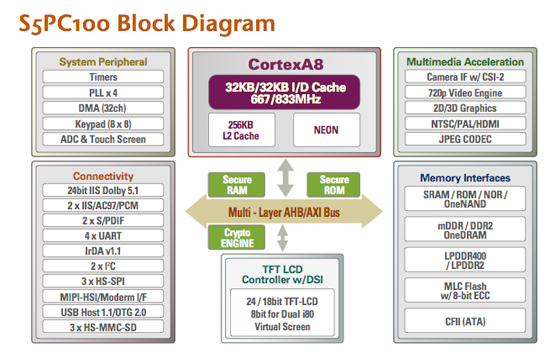Understanding the iPhone 3GS
by Anand Lal Shimpi on July 7, 2009 12:00 AM EST- Posted in
- Smartphones
- Mobile
Putting it in Perspective
Below is a table of the CPUs used in some of the top smartphones on the market, let’s put our newly refreshed knowledge to the test.
| CPU | Issue Width | Basic Pipeline | Clock Speed | |
| Apple iPhone/iPhone 3G | Samsung ARM11 | single | 8-stage | 412MHz |
| Apple iPhone 3GS | Samsung ARM Cortex A8 | dual | 13-stage | 600MHz |
| HTC Hero | Qualcomm ARM11 | single | 8-stage | 528MHz |
| Nokia N97 | ARM11 | single | 8-stage | 424MHz |
| Palm Pre | TI ARM Cortex A8 | dual | 13-stage | 600MHz |
| RIM Blackberry Storm | Marvell ARM11 | single | 8-stage | 624MHz |
| T-Mobile G1 | ARM11 | single | 8-stage | 528MHz |
The first thing you’ll notice is that there are a number of manufacturers of the same CPUs. Unlike the desktop x86 CPU market, there are a multitude of players in the ARM space. In fact, ARM doesn’t manufacture any processors - it simply designs them. The designs are then licensed to companies like Marvell, Samsung, Texas Instruments and Qualcomm. Each individual company takes the ARM core they’ve licensed and surrounds it with other processors (e.g. graphics cores from PowerVR) and delivers the entire solution as a single chip called a System on a Chip (SoC). You get a CPU, GPU, cellular modem and even memory all on a single chip, all with minimal design effort.

A derivative of this is what you'll find in the iPhone 3GS
While it takes ARM a few years to completely architect a new design, their licensees can avoid the painful duty of designing a new chip and just license the core directly from ARM. ARM doesn’t have to worry about manufacturing and its licensees don’t have to focus on building world class microprocessor design teams. It’s a win-win situation for this business.
For the most part, ARM’s licensees don’t modify the design much at all. There are a few exceptions (e.g. Qualcomm’s Snapdragon Cortex A8), but usually the only things that will differ between chips are clock speeds and cache sizes.
The fundamentals of the architectures don’t vary from SoC to SoC, what does change are the clock speeds. Manufacturers with larger batteries and handsets can opt for higher clock speeds, while others will want to ship at lower frequencies. The ARM11 based products all fall within the 400 - 528MHz range. These are all single-issue chips with an 8-stage pipeline.
| iPhone 3G (ARM11) | iPhone 3GS (ARM Cortex A8) | |
| Manufacturing Process | 90nm | 65nm |
| Architecture | In-Order | In-Order |
| Issue Width | 1-issue | 2-issue |
| Pipeline Depth | 8-stage | 13-stage |
| Clock Speed | 412MHz | 600MHz |
| L1 Cache Size | 16KB I-Cache + 16KB D-Cache | 32KB I-Cache + 32KB D-Cache |
| L2 Cache Size | N/A | 256KB |
The iPhone 3GS and the Palm Pre both ship with a Cortex A8. I’m actually guessing at the clock speeds here, there’s a chance that both of these devices run at closer to 500MHz but it’s tough to tell without querying the hardware at a lower level. The Cortex A8 gives us a deeper pipeline, and thus higher clock speeds, as well as a dual issue front end. The end result is significantly higher performance. Apple promised > 2x performance improvements from the iPhone 3GS over the iPhone 3G, such an increase was only possible with a brand new architecture.

I must stress this again: clock speed alone doesn’t determine the performance of a processor. Gizmodo’s recent N97 review complained about the speed of Nokia’s 424MHz processor (rightfully so). The review continued by saying that HTC uses 528MHz processors, implying that Nokia should do the same. The second part isn’t what Nokia should be doing on its $500+ smartphone, what is inexcusable is the fact that Nokia is not using ARM’s latest and greatest Cortex A8 on such an expensive phone. It’s the equivalent of Dell shipping a high end PC with a Core 2 Duo instead of a Core i7; after a certain price point, the i7 is just expected.










60 Comments
View All Comments
psonice - Tuesday, July 7, 2009 - link
My understanding is that the iphone 3gs GPU is actually a 535, not a 520. At least, this is the current understanding among iphone developers, and there's an SGX535 driver on the phone to support that. The extra power might explain the hit on battery life when playing games.Real numbers are pretty hard to come by, but it seems the 535 is roughly 4x faster than the 520. If so, that's a massive upgrade rather than just a decent one. The 535 also supports HD video decoding where the 520 doesn't - not that apple seem to be supporting it if it does.
I heard too that the palm pre has a 530 GPU, which is 2x faster than the 520. That puts the iphone a long way ahead for graphics instead of behind.
One thing in the article I really disagree with btw: you say that the phone makers should provide detailed specs. I think they shouldn't, as it's not helpful at all for the average buyer. If you go into a shop without having much clue and ask for an iphone because it's the latest thing, and the shop assistant says "well this is like an iphone, but it runs 200mhz faster" you'll end up buying the "better" phone based on the spec sheet, even if it's running win mobile 5.
I was in Japan a while back, and they tend to buy phones based on the spec sheets there. The phones all compete on having the most features. They're all really big and HORRIBLE to actually use. None of that please!
I think apple actually get their commercials right with the iphone on the whole: show somebody actually using the phone to do stuff. If the other manufacturers did the same, that would be a perfect way to compare.
christinme7890 - Thursday, July 9, 2009 - link
I agree with you holistically. There are not many people in this world that even understand the specs. Not to mention when it comes to specs, and the person has no clue, they end up getting the one with the highest numbers. This is bad. I think you are right in saying that the way apple works their commercials is perfect for people. They show people all the great apps that they could use and they say that ALL of these apps can be on one phone.This is why I hate the Best buy MS commercials where the kid goes into the BB and buys a PC instead of a mac. The person always buys the computer with the best specs and care little about the OS, which is what they will be using. Windows, imo after using a Mac for a year, sucks in comparison to Mac. I rarely have a problem with a mac. I sit in class everyday and watch all the pc people have startup errors and os sleep or hibernation errors. I can close my mac and KNOW WITHOUT A DOUBT that it will wake up totally fine. Not to mention it wakes up seamlessly without load screens or anything. I will not compare the two but for business and usability the MAC gets my vote and I think if Apple does their commercials for the macs just as great. Sure most people are still using MS but that is because MS strong arms people into buying their stuff everytime you buy a Computer (not to mention Apple is very strict with their software and rightly so).
Anand Lal Shimpi - Tuesday, July 7, 2009 - link
Ooh, very interesting - do you have any links to discussions on the 535 being in the 3GS?I don't think end users need to be bombarded with specs, but I think there needs to be more information put out about these things. We shouldn't have to play guessing games about clocks and specs; don't market them, but don't hide them either - that's my thinking.
Take care,
Anand
BlazingDragon - Tuesday, July 7, 2009 - link
Anand, here it is:http://www.macrumors.com/2009/06/25/iphone-3gs-has...">http://www.macrumors.com/2009/06/25/iph...has-more...
Anand Lal Shimpi - Tuesday, July 7, 2009 - link
Very interesting - thanks guys, I've updated the article.Take care,
Anand
ltcommanderdata - Tuesday, July 7, 2009 - link
It should probably also be noted that the MBX-Lite supports OpenGL ES 1.1 as implemented by Apple not just OpenGL ES 1.0. I believe it's Android's implementation that currently only supports OpenGL ES 1.0.It's also been reported that the iPhone OS 3.1 betas include improvements to the OpenGL stack that include additional OpenGL extensions. Whether these are focused on OpenGL ES 2.0 and the SGX or are also for OpenGL ES 1.1 and the MBX remains to be seen. Although on the issue of reducing market segmentation, it'd be great if Apple could implement the OpenGL ES 1.1 Extension Pack although I don't know if the MBX-Lite can actually support it in hardware.
BlazingDragon - Tuesday, July 7, 2009 - link
Anand, here's it is:iPhone 3GS Has More Powerful PowerVR SGX 535 GPU?
kelmerp - Tuesday, July 7, 2009 - link
I'm trying to decide between the MyTouch or a jailbroken iphone.sxr7171 - Wednesday, July 8, 2009 - link
JB iPhone vs. MyTouch? They're not even in the same league. Pre vs. iPhone is a comparison.pennyfan87 - Tuesday, July 7, 2009 - link
anand,i love you writing and tech analysis.
but please, drop the fanboyism.
3 articles on such a minor upgrade? please.
more SSD stuff please.